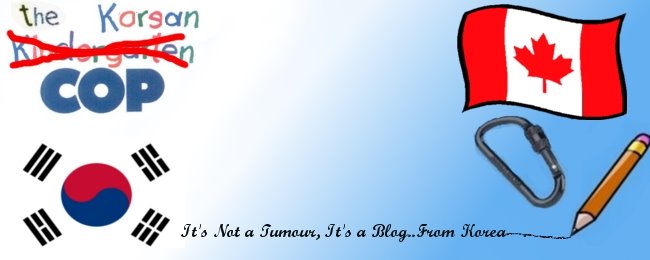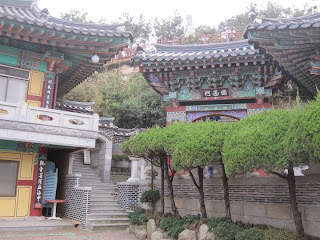My final day was spent frantically trying to get my luggage, my money, and then get on my plane, followed by a 25 hour journey home. In short, it was the most hectic day ever.
When I left Tyler’s home for Busan last week, I had only taken one small suitcase for the trip and had left my other, larger suitcase there (at Tyler's home). I had planned to get the suitcase last night when I came back from Daejeon, thus saving me a trip in the morning, but due to Jun’s test I had to push back my departure from Daejeon, subsequently arriving in Seoul too late to get my luggage.
Tyler works during the morning and the afternoons, so I only had a small window of opportunity to meet him at his home today to get my luggage back before my flight back to Canada. The trip to his home takes an hour each way, and so I did not arrive back to Jin Guesthouse (where I was staying again) until 2:30 PM.
I still had to get to the airport for a 5:20 boarding call, and the trip to Incheon takes about an hour and a half. Before I could leave for the airport though, I had to first collect my salary for December from my boss. My salary had not been available before I left, because all the schools were on holidays, so I had to wait until today to get my salary.
Unfortunately, there were some issues with the bank, and the money did not clear until the last minute. I was too late to catch the unbelievably comfortable airport limousine (bus), so I had to hail a cab. I made sure this time to get a grey cab, instead of one of the unbelievably expensive black cabs like I got tricked into taking on the trip to Seoul from the airport back in August.
Thanks to my driver going 140 km/h in 80 km/h zones (Korean "bullet taxis" rule), I was able to make up considerable time and actually beat the airport limousine bus I would have been taking back to the airport (we passed it on the Incheon bridge). Unfortunately, a group of ten Koreans tried to buy tickets at the last minute in the Baggage Check-in Line, and so I was forced to spend 45 minutes waiting as I watched my extra time waste away. Just as it was my turn to approach the desk, the employee decided to shut down his station, and so I had to go to the end of another line and wait there as yet more precious minutes ticked away.
When I did finally get my luggage checked in, I had about 5 minutes until my plane started boarding on the other side of the airport. I was told to "hurry there", but I still had to exchange my massive wad of Korean won for Canadian dollars (I had about two month’s worth of salary in the equivalent of $10 bills to exchange).
Some may wonder why I would not just exchange my money in Canada and head to my plane, but The Royal Bank of Canada buys Korean won at about 75% of the going rate, and I wasn't about to lose half a month’s worth of money to the fat cats at the RBC. I did bite the bullet in the end and go to a currency exchange place at Incheon International Airport, because I didn't have time to find the right bank amidst all the duty free shops and restaurants. However, it didn't really matter because the rates at this booth were only 5/1000 of a dollar, per dollar, than the bank's rate to which I would have gone, and only 1/100 of a dollar, per dollar, more than the going exchange rate for changing Korean won to Canadian dollars.
After the man at the exchange booth took his sweet time exchanging my money (I can’t blame him too much, as he needed to find a suitcase in which to store it all), I had negative three minutes to get across the airport and board my plane.
At the security area, another plane was boarding at the same time, and so I got stuck in a swarm of people. To make matters worse, the line I was in shut down three people before I got to the conveyor belt to scan my carry on luggage, and so I had to go to the back of a different line and wait all over again.
When I finally did make it through security, I then had to get through immigration, race across the airport and down four stories to the monorail train that would take me to the International departures area, where I then had to race back up four floors to finally make it to my gate, where I made it on the plane with just six people to spare.
Unlike my flight from Canada to Seoul in August, the trip back across the ocean was quite comfortable. I even made it to the luggage carousel at the Vancouver International Airport and picked up my luggage in time to get to check it on my next plane (during my trip in May I nearly missed my flight because I forgot my carry-on in the overhead compartment of the plane from Seoul).
However, the young Korean I had met on the plane could not find one of his bags because another passenger had mistaken it for his/her identical piece of luggage earlier. Add to this delay the fact that I misplaced my customs declarations slip and had to retrace all my steps to find it again, and I once again found myself in another tight race to board my next plane. Eventually though I made it home, and my second journey to Korea finally came to an end.
Epilogue:
Many people ask me what my plans are now, or if I’ll ever go back to Korea. At the moment I have 8 Korean textbooks, and when I have mastered each book and committed them all to memory I plan to return to Korea to study Korean as a Second Language.
Eventually my goal is to master Korean so well, that I can become one of the few, if not the first ever Westerner to teach a subject in Korean in a Korean public school. In short, I hope to become a real Korean school teacher.



































